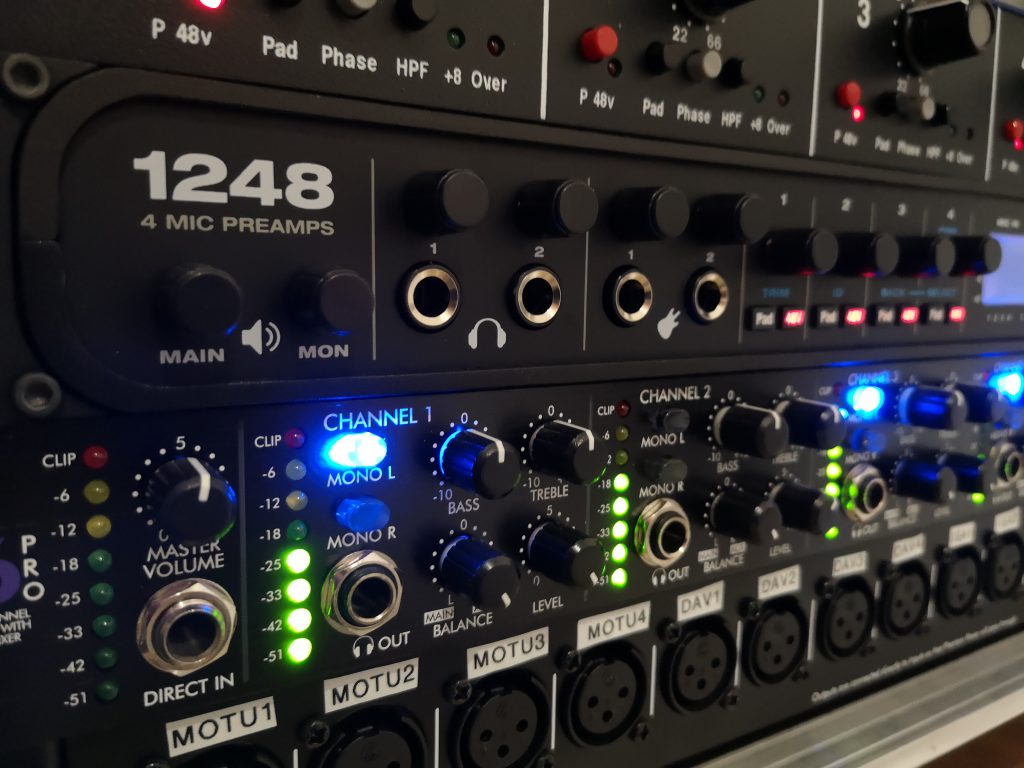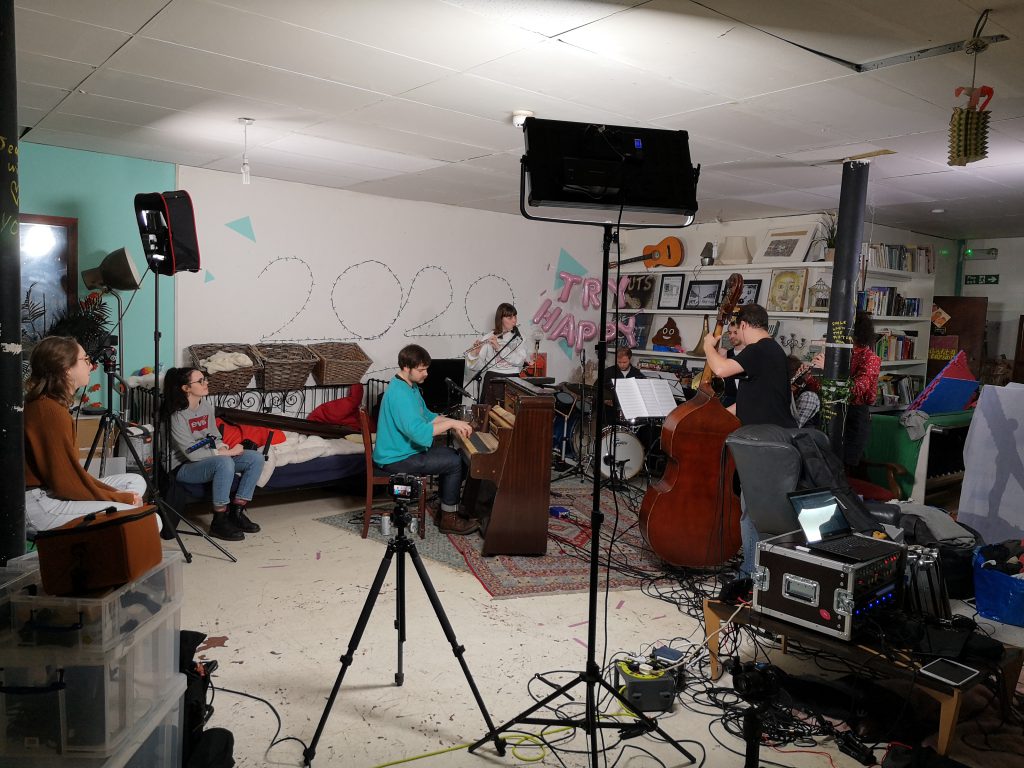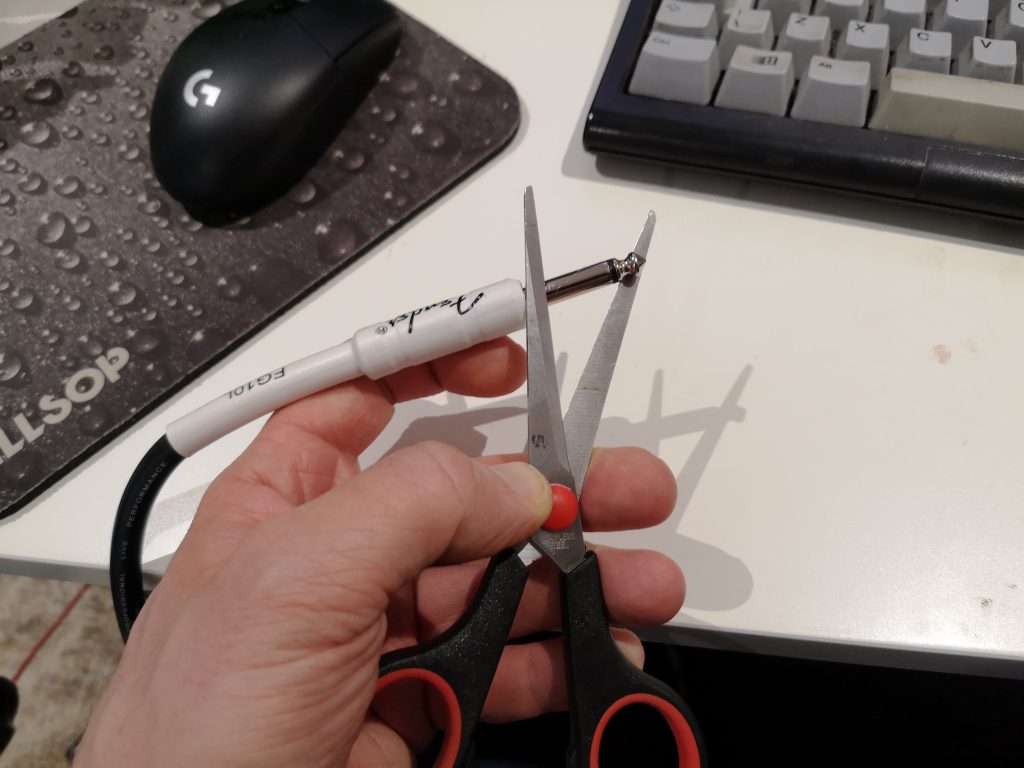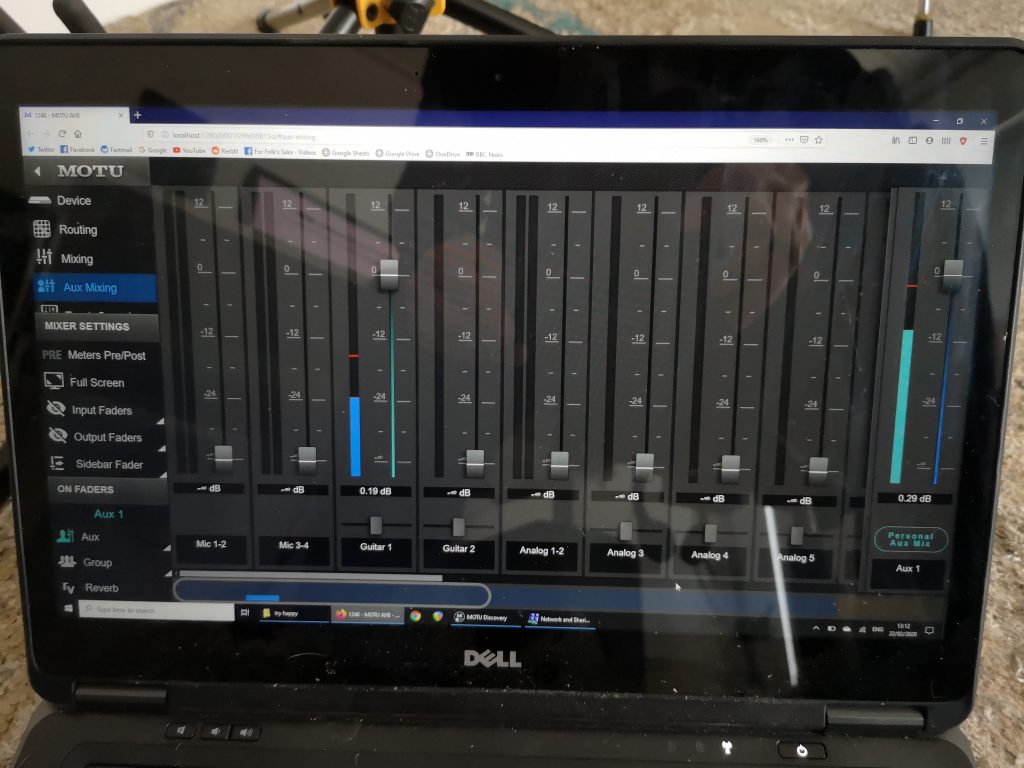It’s audio interface upgrade time at the studio. I’ve swapped my Focusrite Scarlett 18i20 (2nd gen) for a MOTU 1248.

There were a few motivations for this. One was to expand/improve the support for external mic amps. Another was to improve how I handle headphone mixing for live monitoring.
With the Scarlett I could offer headphones to a few performers, but not with any reverb which some singers prefer. For larger groups it got more tricky as the Scarlett only offers five custom mixes. But these mixes are stereo so you can start panning left/right to split into ten (really eight given the number of outputs) but it’s hard work. I did it this way for the Beechmast recordings and it took an age to get everyone setup. The 1248 allows enough truly separate ‘aux mixes’ to cover a band, and also allows the performers to adjust their own mix directly rather than everything having to go through me.
The first use of the interface was an on-location session for Try Happy who that day were playing as a seven piece. I’ve also since used it for a studio session.

The Good
In the grand scheme of things, the 1248 is a mid-priced interface. Comfortably above the Scarlett range but comfortably below the Antelopes, Apollos, Prisms etc. The closest equivalent would be the RME 802.
Compared to the 802 it’s good value. You get two extra inputs (the dedicated instrument jacks on the front), four extra outputs, better specced in/out convertors with +24dBu support, user-controlled aux-mixes and digitally controlled pre-amps (for easier stereo matching). It also keeps all of those advantages, bar the last, over the more expensive RME UFX, although the UFX has a few unique tricks of it’s own such as recording direct to USB.
The twelve outputs (vs eight on the RME) is useful as it allows a permanent setup of having eight outputs wired into a headphone amp, two for main outputs, and also two spares to use as miscellaneous outputs, such as sending to a DI’d guitar to a floor monitor.
Interface-to-PC latency isn’t something I worry too much as it has no effect on live recordings, so I just tend to set all buffers to maximum for safety. But I did some test recordings at the lowest buffer settings and achieved what appeared to be stable recordings with a round trip of 1.5ms over USB which is genuinely impressive.
The only time I care about latency, and then just output latency, is for piano sessions where the sound is generated by a Galaxy Vintage D VST piano. With the Scarlett it always used to be the case I could use 128 sample buffer (3.6ms out) for normal playing but needed a 256 buffer (5.9ms) for key mashing with sustain. Something has clearly changed fairly recently because when I retested for this post I was able to mash keys (over a 3 octave range) with sustain at a buffer of just 16 samples (1.4ms). So that’s news. With the 1248 I was also able to use the lowest buffer (1ms). Which is great by both of them frankly. I think in practice I would set it a bit higher to be safe.

With the Scarlett although ASIO drivers were always rock solid, the drivers for “normal” Windows apps were rubbish (clicks, break-ups etc.) and you couldn’t really use the interface as a normal sound card. The 1248 drivers are fine in both modes which is nice for me as I can easily switch between Reaper and Premiere without having to also flip my amp input.
Lastly, it’s impressively small and light. Noticeably so compared to the Scarlett. If you picked your other components carefully you can have a very compact and lightweight mobile rig.
The OK
There isn’t any dedicated control software for the interface, and instead this is all done via a Web interface to a server running on the 1248 itself. This is a mixed blessing. It’s good in that it’s cross-platform and performers can control their mixes from their phones without having to install anything but the experience isn’t as good as a native application. For performers just using it briefly it’s fine, but as something I have to live with all the time it feels very compromised.
Web apps are just less efficient. As a comparison here’s the UI running on an elderly (2012) iPad compared to the Zoom F8 mixer which is a native app. The 1248 interface takes almost a minute to appear and then is barely responsive. The F8 app starts in under 10 seconds and responds nicely. Yes, it’s a more simple mixer but most of what you’re seeing here is Web overhead. I keep that iPad around just for the Zoom app, it’s a shame it couldn’t also serve as a guest mixing control tablet.
On a real PC it’s much better of course, but even on a relatively powerful desktop it takes a few seconds to switch to the main mixer screen, and still has that slightly sluggish feeling.
All that said, the UI does work. For the Try Happy recording I spent 5 mins getting everyone connected to an old broadband router I brought along and onto the landing page and from there everyone was able to control their mixes without any further intervention or training, aside from some bug issues (see below). It was massively better than my previous experience of headphone monitoring with the Scarlett.
Although the marketing blurb for the 1248 mentions the ability to have seven stereo (14 mono) aux-mixes it doesn’t make clear this is only for 48KHz. At 96KHz this number drops to just three stereo (six mono). This means in stereo terms the 1248 actually has fewer custom mixes than the Scarlett at 96KHz. At 192KHz, which I never use, the number of aux-mixes stays the same, (probably because all realtime FX is disabled freeing up DSP capacity) while the Scarlett loses all hardware mixing.
Speaking of which, running at 96KHz does significantly reduce the number of real-time effects you can run, although it doesn’t affect me in practice. In general, it’s an interface that feels expansive at 48KHz but slightly limited at 96KHz.
The Bad
Whilst I like the fact the 1248 is light, it also feels very cheaply made, significantly below the build quality of the Scarlett (and indeed every other component in my rack, despite being the most expensive). For example, if I press one of the buttons to turn on phantom power all the other buttons in the row move as well. Despite the interface not weighing anything, the rack ears are so thick I can barely screw the interface in with normal screws, and it doesn’t sit flush with other components.
The screen is particularly awful. A monochrome LCD with poor contrast, poor viewing angles and poor refresh rate. Also set back about 5mm from the front panel. There’s a “contrast” control which really controls the viewing angle, and I think the last time I saw one of those was on a MT32. It’s actually quite impressive MOTU managed to find a screen that bad. The screen is only really useful for setting the gain on the internal amps, network settings and confirming the outputs are working. But you can’t really monitor levels with it. It’s also un-dimmable, so just sits there vaguely glowing blue.
However, the biggest problems are the bugs. And so far I’ve found three.
Bug 1: A few times the interface has just stopped outputting any sound. Everything is unmuted, routing is correct but nothing makes it to the output. The fix is to change the sample rate (e.g. from 48 to 96, and then back to 48) which resets things. During the Try Happy recording day this happened twice, but never during a recording phase. My suspicion is that making any change to the mixer may trigger the bug, so when people are fiddling with their settings there’s a risk, but once left alone it’s OK. This one has been hard to reproduce so I’ve been unable to get it on video for MOTU support.
Bug 2: The aux mix channel meters do not reflect the signal level. For a given channel going via an aux mix the final signal level is a combination of the fader on the main (input) mixer and the fader on the aux mix. The meter attached to the aux channel will, correctly, show increased/decreased levels according to the aux mix fader. But the meter is unaffected by the input fader, even though the signal is. Here’s an example:

The fader for the channel (3rd from left) and the output fader (far right) are both set to 0, so logically the meter for the channel should be the same as the output. But you can see the output level is much higher. This is because the input fader for the channel is set to +12.
This all means the channel meters aren’t just useless, but actively misleading. During the Try Happy recording I couldn’t work out why a aux mix wasn’t producing any output even though I could see a signal on the relevant channel. The reason, I suspect now, was that the channel was faded to silence on the input mixer, but the channel meter was still showing a signal so I thought a signal was making it to the aux mix.
Bug 3: Sometimes what you see in the mixer is not what the interface is actually doing. I have seen an occasion where the mixer is showing a channel faded to -inf, but actually the level is actually set to slightly above that (as if the interface missed the final fader move command) so the signal is still coming through. I’ve seen similar situations with non fader settings, but I forget exactly which control it was. You can be looking at the interface and you think everything is OK but actually it’s not because you’re not seeing the actual state.
One other annoyance. To raise a support request with MOTU you need to register and that requires the serial number. I thought it might be the UID from the devices tab on the Web UI but that was rejected. The serial isn’t printed on the back where you might be able to read it, but underneath. It’s not even on the front part of the underneath so you might get away with just pulling the interface slightly out the rack. Nope, you have to unwire everything to get the serial, which in a final FU to the user turns out it is the UID, just with the leading zeros removed. I used unkind words at this point.
Would I recommend it?
No, I don’t think I would. Mostly this is due to the bugs, because job number one for any interface is to be stable and reliable and this isn’t quite there. If the issues all got fixed, and there was a decent native mixer for desktop/tablet then it would be a weak recommend.
Fix those things, improve the build quality a bit and replace that awful screen with anything else, even a monochrome VFD, and it would be a solid recommendation.
Having said that I’ve no idea what I’d recommend in it’s place. Part of me would rather not keep it, but the bugs are liveable and I just don’t know what alternative there is with the same feature set.